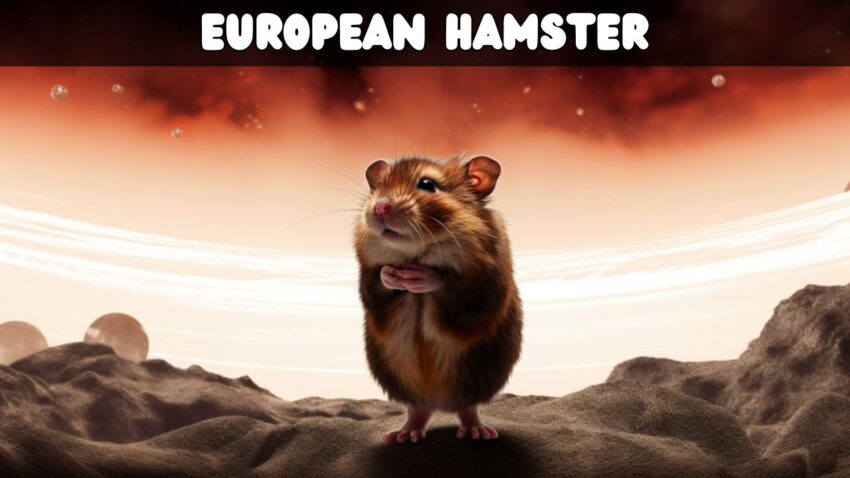The European Hamster, a fascinating creature known for its distinctive appearance and intriguing behavior, has captured the hearts of many across the globe. Whether you’ve had the joy of watching one scamper in the wild or you’re considering welcoming this magnificent species into your home, the journey with the European Hamster is nothing short of remarkable.
Welcoming Readers to the World of the European Hamster
Often, when we think of hamsters, we imagine small, fluffy creatures running on wheels or navigating mazes in a pet store. However, the European Hamster is a species that stands apart, not just in its physical attributes but also in its rich history and the role it plays in its natural habitat. From vast plains to urban settings, this hamster has proven its adaptability and resilience time and again. As you delve deeper into this guide, you’ll uncover the mysteries, beauty, and unique characteristics of the European Hamster, an emblem of nature’s versatility.
A Glimpse of What Lies Ahead in the Article
This comprehensive guide is your one-stop resource, packed with information about the European Hamster. Beyond just facts and figures, we’ve crafted an immersive experience, allowing you to understand every facet of their existence. From their natural behaviors and ideal living conditions to their dietary needs and common health challenges, we’ve covered it all. As we journey through the various sections, you’ll gain a holistic understanding, preparing you for a rewarding experience, whether you’re an enthusiast, a potential pet owner, or simply curious.
Overview

The European Hamster, a species with a rich tapestry of history and an aura of mystery, has fascinated many for centuries. As we embark on this section, we’ll delve into the legacy of this iconic hamster, exploring both its historical significance and its contemporary relevance. Moreover, we’ll shed light on its dual existence, portraying its life in the wild and its transformation as a cherished domestic pet.
The Legacy of the European Hamster: Historical and Contemporary Relevance
Long before the European Hamster graced our homes as endearing pets, it roamed the vast landscapes of Europe, playing a crucial role in the ecosystem. Historically, these hamsters have been integral to the folklore and cultural narratives of many European communities. Their nocturnal habits, hoarding tendencies, and seasonal behaviors became subjects of intrigue and admiration. Fast forward to contemporary times, the European Hamster continues to hold a special place in the hearts of many. Conservationists, researchers, and enthusiasts study this species not just for its captivating behaviors but also for the insights it offers into changing ecosystems, climate adaptabilities, and more. Its relevance has transcended time, making it a continuous subject of study, admiration, and love.
The Dual Existence: European Hamster in Domesticity and in the Wilderness
The wilderness is the European Hamster’s original abode—a place where it exhibits its most innate behaviors, from foraging for food to creating intricate burrow systems. In the wild, their lives are a mesmerizing dance of survival, adaptation, and natural instincts. Their territories stretch across vast fields, forests, and even urban outskirts, showcasing their adaptability.
On the other hand, their transition to domesticity paints a different but equally enchanting picture. As pets, European Hamsters have shown a remarkable ability to bond with their human caregivers, adapt to household environments, and provide endless entertainment with their antics. Their large size, compared to other hamster species, coupled with their distinctive appearance, makes them a popular choice among rodent enthusiasts. In homes, they bring a slice of the wild indoors, reminding us of the intricate balance between nature and nurture.
Natural Habitat

The natural habitat of any species offers a vivid picture of its evolutionary history, adaptations, and the ecological roles it plays. For the European Hamster, understanding its habitat provides insights not only into its behaviors but also into the various environmental factors that have influenced its development over millennia. As we delve deeper into this section, we’ll traverse the territories that the European Hamster calls home and explore the climates and geographical nuances that make these areas ideal for its survival.
Mapping the European Hamster’s Natural Territories
The European Hamster, true to its name, predominantly inhabits regions across Europe, with its range extending from Western Europe to the Ural Mountains in Russia. This hamster has been traditionally associated with vast open fields, grasslands, and farmlands. It’s not uncommon to find them in regions of France, Germany, and parts of Eastern Europe, where they burrow deep tunnels to create intricate underground homes. These burrows, often complex, serve multiple purposes: they provide shelter from predators, act as storage for food, and offer a cozy environment for nurturing their young. Their presence has also been recorded at the edges of urban areas, indicating their adaptability to changing landscapes.
Climatic Preferences and Geographical Niches that Host the Species
Adaptable and resilient, the European Hamster thrives in temperate regions where the climate offers a balance of warm summers and cold winters. Their thick fur not only gives them their characteristic appearance but also equips them to deal with colder temperatures, especially during hibernation. These hamsters have developed behaviors that sync with the changing seasons; for instance, they amass food during the warmer months to sustain during the winter.
The geographical niches that the European Hamster prefers are often characterized by loamy soil, which is ideal for burrowing. The presence of vegetation, especially grains and seeds, is a crucial factor, as it directly influences their diet. Proximity to water sources, though not always essential, can be a determining factor in the density of their populations in a particular region. As agricultural landscapes have expanded, there have been concerns about habitat loss, making the study of their natural environment even more crucial for conservation efforts.
Physical Characteristics

Diving into the world of hamsters, one is often struck by their delightful appearance and the nuances that set each species apart. The European Hamster, in particular, stands out for its unique features, which have been shaped by its habitat and evolutionary journey. As we journey through this section, we’ll unveil the various physical attributes that make the European Hamster a subject of admiration for enthusiasts and researchers alike.
From Fur to Whiskers: A Detailed Examination of the European Hamster
The European Hamster is notably larger than many of its cousins, with adults often reaching lengths of up to 25-35 cm, a size comparable to a small guinea pig. This robust size aids them in surviving the challenges of their natural habitats. Their fur, a rich blend of browns, blacks, and whites, not only serves as camouflage in grasslands and open fields but also plays a crucial role in temperature regulation.
One of the most striking features of the European Hamster is the black patches around their eyes, giving them the appearance of wearing little masks. These patches contrast beautifully with their white cheeks and underbelly. The fur on their back ranges from golden brown to dark brown, providing further camouflage against predators. Their short, stubby tails, often overlooked, play a significant role in balance and movement, especially when they are swiftly navigating their underground burrows.
The European Hamster’s whiskers, long and sensitive, provide tactile feedback, essential for nocturnal creatures. These whiskers help them navigate in the dark, detect changes in their environment, and even sense predators. Their incisors, like all rodents, continue to grow throughout their lives, and they instinctively gnaw on various materials to keep them in check.
Adaptations and Evolutionary Insights
While the immediate physical appearance of the European Hamster is undoubtedly fascinating, understanding the evolutionary adaptations that have led to these features offers an even more intriguing exploration. Each trait, from their fur patterns to their robust size, tells a tale of survival, adaptation, and evolution.
Over the millennia, the European Hamster has faced numerous challenges in its habitats, ranging from extreme cold to potential threats from predators. These challenges have led to specific adaptations. For instance, their fur not only provides camouflage but also insulation during colder months. The layer of subcutaneous fat they develop just before winter acts as an energy reserve during hibernation, a behavior not commonly observed in many other hamster species.
Their strong, curved claws are perfect for digging and creating intricate burrow systems. These burrows, often quite complex, serve multiple purposes: they are a refuge from predators, a place to store food, and a cozy spot for reproduction and raising their young.
In essence, every aspect of the European Hamster’s physicality speaks to a long history of adaptation to its environment, making it not just a captivating species to observe, but also a testament to the wonders of evolutionary biology.
Behavior and Temperament

The European Hamster, beyond its distinctive physical characteristics, also presents a behavioral pattern that offers insights into its daily life and natural inclinations.
A Day in the Life: Routine and Interactions of the European Hamster
Like most hamsters, the European Hamster is primarily nocturnal, meaning its most active periods are during the night. Their nights are occupied with foraging for food, maintaining their burrows, and in the case of males, seeking out potential mates or establishing territory. During the day, they prefer to stay hidden within the depths of their burrows, a behavior that helps them evade daytime predators and the harsh sunlight.
Their burrows are more than just sleeping quarters. These underground labyrinths consist of multiple chambers designated for various purposes – storage for food, nesting, and waste. An interesting aspect of their behavior is their meticulous nature in separating their food storage from their nesting and waste areas, highlighting their innate cleanliness.
When it comes to social interactions, the European Hamster is largely solitary, especially the males. They can be quite territorial and may exhibit aggressive behavior when their territory is invaded. This territoriality is especially evident during the breeding season when males are vying for the attention of females.
Traits that Set Them Apart: Unique Behaviors of the Species
One of the most distinctive behaviors of the European Hamster is its method of food storage. Unlike many animals, this hamster species hoards vast amounts of food in its burrows. This behavior can be attributed to the unpredictability of food sources in their natural habitat, especially during winter. They stockpile grains, seeds, and even chunks of vegetables, ensuring they have a steady food supply when external conditions are unfavorable.
Another unique trait is their hibernation behavior. While many hamster species do not hibernate, the European Hamster goes into a deep hibernation during the colder months. During this period, their metabolic rate drops significantly, and they rely on their stored food and body fat to survive.
The vocalizations of the European Hamster are also worth noting. They have a range of sounds that they use for various purposes – from warning calls to mating signals. Each sound offers a small window into their emotional state and intent, making them a fascinating species to study and observe.
In summary, the behavior and temperament of the European Hamster are as captivating as their physical appearance, with each action and sound providing a deeper understanding of their nature and way of life.
Of course, I’ll elaborate further on the section.
Diet and Nutrition

Delving into the dietary preferences of the European Hamster provides not only fascinating insights but also essential knowledge for those looking to care for one. These hamsters, with their unique dietary needs, emphasize the significance of diet in determining health, activity levels, and overall well-being.
From Seeds to Veggies: A Comprehensive Look at the European Hamster’s Diet
The European Hamster, being an omnivore, boasts a versatile dietary palette that encompasses a wide range of foods. In their natural habitat, they primarily forage on seeds, grains, and legumes, while also indulging in the occasional fresh vegetables, green shoots, and even certain roots and tubers. These adept foragers often stash away food in specialized cheek pouches, later storing their finds in burrows. This clever behavior ensures they have a continuous food supply during harsher seasons or their hibernation periods.
Supplementing their plant-based diet, European Hamsters also consume small insects, especially when they need an extra protein boost. This inclusion of both plant and animal matter in their diet showcases their adaptability and the need for a balanced dietary intake.
Nutritional Guidelines and Foods to be Cautious of
For those who house a European Hamster as a cherished pet, it’s of paramount importance to mimic its natural diet as authentically as possible. A balanced dietary regimen would include hamster pellets, which are often fortified with essential nutrients, a variety of fresh vegetables, fruits, and even an occasional serving of protein-rich sources like mealworms or crickets.
However, the European Hamster’s diet isn’t just about what they should eat but also what they must avoid. Certain foods can be detrimental to their health. Citrus fruits, for example, are too acidic; onions and garlic contain compounds that can harm their red blood cells, and sugary or caffeinated foods and beverages can be toxic. Chocolates, a favorite for many humans, are particularly harmful, containing theobromine, which is poisonous to many animals, including these hamsters.
Hydration is as crucial as nutrition. Ensure your hamster has a constant supply of fresh water. Observing their eating patterns, adjusting portion sizes, and providing a diverse diet can prevent overeating and its associated health complications. Regularly consulting with a veterinarian specializing in small animals can also provide tailored nutritional advice, ensuring your hamster thrives.
Housing and Environment

Caring for a European Hamster goes beyond just feeding and playing; it also encompasses providing a habitat that closely mirrors their natural environment. This doesn’t just ensure the hamster’s well-being, but can also significantly extend its lifespan, making it crucial for responsible pet owners.
Designing the Perfect Home: Housing Essentials for the European Hamster
When considering housing for the European Hamster, spaciousness is paramount. Unlike some of their tinier cousins, European Hamsters need ample space to roam, forage, and indulge in their natural behaviors. A large, sturdy cage, preferably with multiple levels and a solid floor, is a must. Wire-bottomed cages can lead to injuries and should be avoided.
Inside this cage, provisions for burrowing are essential. Hamsters have an inherent need to dig and burrow, and thus a deep layer of bedding (unscented paper-based or aspen wood shavings) should line the bottom. This bedding should be spot-cleaned daily and fully replaced at least once a week to maintain hygiene.
Beyond bedding, the habitat should be adorned with other essentials: a nest or hideaway for the hamster to sleep, wooden chew toys to help maintain their ever-growing teeth, tunnels for exploration, and a sturdy exercise wheel for physical activity. Water should be provided via a drip bottle, ensuring a continuous supply without contaminating the bedding.
Setting the Mood: Ideal Environmental Conditions and Settings
European Hamsters are used to a temperate climate, so their domestic environment should mirror this. The ideal temperature range lies between 20°C to 24°C (68°F to 75°F). Extreme cold or heat can be detrimental, leading to health complications or hibernation.
Lighting also plays a pivotal role in the hamster’s habitat. These creatures are crepuscular, meaning they are most active during dawn and dusk. Therefore, their housing should be kept in a location that follows a natural day-night cycle, avoiding direct sunlight or pitch darkness. If the room is artificially lit for prolonged periods, it might disrupt their natural sleep-wake cycle.
Ventilation is another aspect to consider. A fresh, draft-free air supply is essential, but direct drafts or positioning the cage next to an open window can lead to colds or respiratory issues.
Lastly, while European Hamsters are solitary in nature, their environment should be enriched with toys and occasional treats to stimulate their senses and prevent boredom. This keeps them engaged, active, and mentally healthy.
Ensuring a harmonious blend of the right housing equipment with perfect environmental conditions guarantees a comfortable, stimulating, and health-optimized habitat for the European Hamster.
Health and Wellness

The European Hamster, like all pets, requires vigilant attention to its health and wellness. While they are hardy animals, they are not immune to ailments. Being aware of common health challenges and understanding when to seek professional intervention can make all the difference in ensuring a long, healthy life for your furry friend.
Common Health Challenges and Their Prevention for European Hamsters
- Wet Tail: One of the most notorious illnesses among hamsters, Wet Tail is a severe diarrheal disease. It’s often caused by stress, sudden changes in diet, or unsanitary living conditions. The best prevention is ensuring a clean habitat, a stable diet, and minimal stress.
- Respiratory Infections: Drafts, sudden temperature changes, or damp bedding can lead to respiratory issues. Symptoms include sneezing, wheezing, and discharge from the nose or eyes. Using dry bedding, keeping the cage away from drafts, and maintaining a stable room temperature are preventive measures.
- Dental Problems: Hamster teeth never stop growing. Overgrown teeth can lead to eating difficulties. Providing wooden chew toys or hard treats can help naturally trim their teeth.
- Tumors: Older European Hamsters may develop tumors, especially females. Regularly feeling the hamster’s body for lumps can help detect these early.
- Parasites: Mites, ticks, and fleas can plague hamsters. Ensuring cleanliness, using only sanitized bedding, and periodic checks can help prevent these pests.
- Nutritional Deficiencies: An imbalanced diet can lead to various health challenges. Offering a diversified diet with high-quality commercial hamster food supplemented by fresh fruits and vegetables (sparingly) ensures they get all necessary nutrients.
When to Seek Professional Care: Recognizing Warning Signs
Recognizing when something is amiss is half the battle. Here are some critical warning signs that your European Hamster might need a vet:
- Behavioral Changes: A usually active hamster becoming lethargic, or a calm one turning aggressive, can be indicative of underlying issues.
- Appetite Loss: If the hamster refuses food or water for more than two days, it’s a definite red flag.
- Changes in Droppings: If you notice diarrhea, oddly colored droppings, or none at all, it may signal digestive problems.
- Bald Patches or Skin Redness: This could be due to skin infections, parasites, or allergies.
- Difficulty Breathing: If the hamster seems to be gasping, wheezing, or breathing rapidly, it needs immediate attention.
- Unsteady Movement: If the hamster is limping, wobbling, or seems disoriented, it might have suffered an injury or be experiencing a neurological issue.
A general rule of thumb for all pet owners is to trust their instincts. If something seems off, it probably is. Periodic check-ups, even when the hamster seems perfectly healthy, can also go a long way in catching potential issues before they become severe.
Breeding

Breeding hamsters, especially a distinct species like the European Hamster, is a delicate process that requires knowledge, preparation, and commitment. Not only is it about understanding the science and nature of their reproductive cycles, but it’s also about ensuring that the entire process is carried out responsibly and ethically, keeping the well-being of the animals at the forefront.
The Journey of Procreation: Breeding Protocols and Cycles
- Understanding the Reproductive Cycle: Female European Hamsters come into heat approximately every four days. It’s during this period that they are receptive to males. Recognizing signs of heat, such as a swollen vulva and a musky odor, is crucial.
- Age of Breeding: Typically, European Hamsters are ready to breed from three to four months of age, though it’s often recommended to wait until they are at least five to six months old to ensure they are mature enough for the process.
- Pairing and Introductions: When introducing a male and female for breeding, it’s essential to be vigilant. Initial meetings should be supervised to ensure no aggressive behavior occurs.
- Gestation and Birth: Once pregnant, the gestation period for European Hamsters is approximately 18-20 days. It’s vital to provide a pregnant female with ample nutrition and a quiet, stress-free environment.
- Post-birth Care: After birth, it’s advisable to minimize disturbances. Mothers can be protective and, if stressed, might display aggressive or even cannibalistic tendencies towards the newborns.
Breeding the European Hamster: Ethical Perspectives and Considerations
- Purpose of Breeding: Breeding should never be a casual decision. It’s essential to have a clear purpose, whether for conservation efforts or ensuring the continuation of healthy genetic lines. Breeding just for the sake of having baby hamsters or for profit without considering their future is not responsible pet ownership.
- Overpopulation Concerns: With the potential for large litters, there’s a risk of overpopulation. Before breeding, one must be prepared with plans for the offspring, ensuring they will have loving homes or appropriate facilities to live in.
- Genetic Diversity: Inbreeding can lead to health issues and congenital disabilities. Responsible breeders ensure diverse genetic lines and avoid breeding close relatives.
- Health Checks: Before breeding, both male and female hamsters should undergo health checks to ensure they aren’t carriers of genetic diseases and are in good health.
- Life After Breeding: Once breeding females are retired, they deserve a comfortable, caring environment for the rest of their lives.
- Education and Awareness: Breeders have a responsibility to educate potential new hamster owners. This includes the care requirements of the European Hamster, their lifespan, potential health issues, and overall needs.
Breeding is a significant commitment, and it’s imperative to approach it with the respect and responsibility it warrants. The goal should always be the well-being of the animals and the continuation of healthy, happy European Hamsters.
FAQs

The world of the European Hamster, with its unique characteristics and needs, often leaves enthusiasts and potential pet owners with several questions. In this section, we aim to address some of the most commonly asked questions about this remarkable species.
Resolving Doubts: Addressing Popular Questions About the European Hamster
How long does the European Hamster live?
Typically, the European Hamster has a lifespan of 5-8 years in captivity when provided with the proper care and nutrition. In the wild, due to various factors like predators and environmental challenges, their lifespan can be shorter.
Can European Hamsters be kept with other hamsters?
It’s generally not advised to house European Hamsters with other hamster species. They can be territorial, and cohabitation might lead to aggressive behaviors and conflicts.
Are they nocturnal creatures?
Yes, like many hamster species, European Hamsters are nocturnal, which means they are most active during the night and prefer resting during the day.
What type of bedding is best for European Hamsters?
Paper-based beddings or aspen shavings are recommended. Cedar and pine shavings should be avoided due to the presence of oils that can be harmful to hamsters.
Is it safe to feed them fruits and vegetables?
Yes, European Hamsters can eat fruits and vegetables, but it’s essential to introduce them gradually and ensure they are fresh. Also, some foods, like onions and citrus fruits, should be avoided.
How often should their cage be cleaned?
A full cage clean should be done every week, with spot cleaning conducted every couple of days to remove soiled bedding and uneaten food.
Can European Hamsters be trained?
While they may not be trainable in the same way dogs or cats might be, with patience, they can be conditioned to certain behaviors, such as coming when called or using a designated area for waste.
Do they require regular vet check-ups?
Regular health check-ups are a good idea, especially as they age. It’s also essential to have a vet who is familiar with hamsters and their specific health needs.
Is it necessary to provide them with a wheel for exercise?
Yes, providing a wheel allows them to engage in their natural running behavior, crucial for their physical and mental well-being. Ensure the wheel is of appropriate size and solid-surfaced to prevent any injuries.
How do I know if my European Hamster is stressed or unwell?
Changes in behavior, appetite, or physical appearance can be indicators. Look for signs like lethargy, aggressive behavior, weight loss, or a matted coat.
Through understanding and knowledge, we can ensure that the European Hamster leads a life filled with happiness, health, and comfort. Always strive to be an informed pet owner, and when in doubt, seek expert advice.
Conclusion

The European Hamster, with its unique attributes and intriguing behaviors, stands as a testament to nature’s vast array of creatures. Throughout this comprehensive guide, we’ve journeyed through the intricate nuances of this species, from its native habitats to the intricacies of its diet, understanding its physical characteristics, and delving deep into its behavioral patterns.
Recapping the World of the European Hamster
Delving into the European Hamster’s world, we’ve discovered a species that’s as fascinating as it is endearing. Its rich history, combined with its presence in both the wild and our homes, has painted a comprehensive picture of a hamster species that requires understanding, care, and respect. Whether it’s their nocturnal antics, their dietary preferences, or their unique behavioral quirks, the European Hamster continues to be a subject of intrigue and admiration for many.
A Call to Arms: Share, Adopt, and Promote Responsible Pet Ownership
As we conclude our deep dive into the world of the European Hamster, it becomes evident that knowledge and awareness are the cornerstones of responsible pet ownership. If you’ve found value in this guide, we urge you to share it with others. The more individuals understand about the European Hamster, the better equipped they’ll be to provide them with the love, care, and environment they deserve.
Furthermore, if you’re considering adding a European Hamster to your family, do so with an informed perspective. Remember, adopting a pet is a long-term commitment, and understanding their needs is paramount to ensuring their well-being. By promoting responsible pet ownership, we not only enrich our lives but also ensure a brighter future for these captivating creatures.

